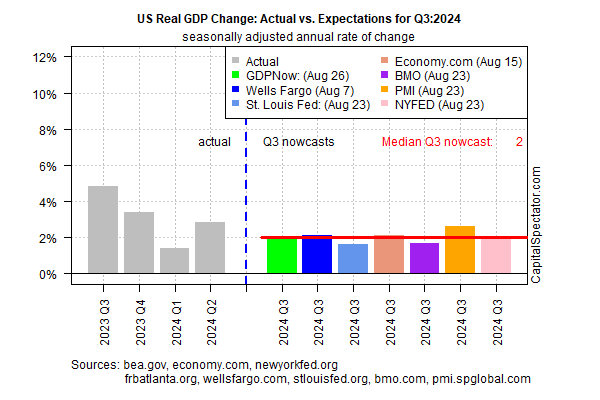If a recession in the US has started or is imminent, the threat has yet to show up in the latest run of nowcasts for third-quarter . That’s no guarantee that the economy will continue expanding, but it’s an encouraging sign.
The median estimate, based on numbers compiled by CapitalSpectator.com, continues to indicate moderate growth, albeit at a softer pace vs. Q3.
Economic output is projected to increase by a real 2.0% annualized pace in Q3, according to the median projection. That translates to a slower expansion compared vs. Q2’s solid 2.8% increase.
The Bureau of Economic Analysis is scheduled to publish its first round of Q3 data on Oct 30.

It’s also encouraging to see that today’s median 2.0% nowcast is essentially unchanged from the previous update published two weeks ago (Aug. 13).
Stability in the median nowcast more than halfway into the current quarter implies that uncertainty is ticking lower for the upcoming Q3 GDP report from the government.
A 2.0% growth rate is hardly a boom, but it’s strong enough (assuming it’s correct) to swat away concerns that an NBER-defined contraction is a high-risk threat at the moment.
“The solid growth picture in August points to robust GDP growth in excess of 2% annualized in the third quarter, which should help allay near-term recession fears,” advises Chris Williamson, chief business economist at S&P Global Market Intelligence.
A similarly upbeat Q3 profile has also been reflected in the weekly updates of The US Business Cycle Risk Report, a sister publication of CapitalSpectator.com. More than a week ago I wrote:
“The main business-cycle index for the newsletter – Composite Recession Probability Index (CRPI) — continued to reflect a probability of less than 10% that the economy was contracting (as of Aug. 10).”
In this week’s edition of the newsletter, a similar reading prevails.
Looking ahead to Q4 could bring stronger headwinds, although the necessary calculus is far less reliable vs. the current Q3 analysis. Indeed, with close to half of the current quarter’s data sets published, the odds are increasing that the median Q3 nowcast is a relatively reliable guesstimate that moderate growth will persist for the very near term.
“The underpinnings of the economy look good. Broadly speaking, things look pretty solid,” says Karen Dynan, an economics professor at Harvard University. “When we enter the typical recession, there is usually some underlying weakness. It just doesn’t feel that way now.”
Low risk isn’t zero risk, however. UBS Global Wealth Management, for instance, advises that US recession risk, while still low, appears to be inching up. Yahoo Finance reports:
“UBS Global Wealth Management has raised the odds of a U.S. recession to 25% from 20%, citing weakness stemming from softer jobs growth and the July unemployment data which stoked fears of a downturn. The brokerage in a note on Monday maintained its base case of a soft landing for the economy with consumer spending broadly determining the trajectory of growth; however, it called the outlook ‘cloudy’.”

